This article was medically reviewed by Troy A. Miles, MD. Dr. Miles is an Orthopedic Surgeon specializing in Adult Joint Reconstruction in California. He received his MD from the Albert Einstein College of Medicine in 2010, followed by a residency at the Oregon Health & Science University and fellowship at the University of California, Davis. He is a Diplomat of the American Board of Orthopaedic Surgery and is a member of the American Association of Hip and Knee Surgeons, American Orthopaedic Association, American Association of Orthopaedic Surgery, and the North Pacific Orthopaedic Society.
There are 12 references cited in this article, which can be found at the bottom of the page.
wikiHow marks an article as reader-approved once it receives enough positive feedback. This article received 13 testimonials and 80% of readers who voted found it helpful, earning it our reader-approved status.
This article has been viewed 464,128 times.
Experts say the most common signs of arthritis in the knee is are pain, swelling, and stiffness in your joint.[1] Research shows the most common types of arthritis are osteoarthritis and rheumatoid arthritis. With osteoarthritis, the cartilage in your knees wears away over time, while rheumatoid arthritis is a chronic autoimmune disorder that targets the lining of your joints.[2] If you suspect you have arthritis in your knees, you likely want symptom relief fast. Although it's best to see your doctor, you may also be able to recognize the signs on your own.
Steps
Knowing if You Have Arthritis of the Knee
-
1Assess your risk factors. Depending on the type of arthritis, there are several factors that may make you prone to arthritis of the knee. Although some of these factors are non-modifiable, there are others you can change to reduce your risk of knee arthritis.[3]
- Genes. Your genetic background can make you more susceptible to certain types of arthritis (e.g., rheumatoid arthritis or systemic lupus erythematosus). If you have a family history of arthritis, you may have a higher risk of developing knee arthritis.
- Gender. Men are more likely to have gout, a form of inflammatory arthritis resulting from high levels of uric acid in the blood, while women are more likely to develop rheumatic arthritis.[4] [5]
- Age. You are at a higher risk of developing arthritis as you grow older.
- Obesity. Being overweight puts stress on the joints in your knees and can increase your risk of developing arthritis.
- History of joint injuries. Damage to a knee joint can be partly responsible for the development of osteoarthritis.
- Infection. Microbial agents can infect joints and possibly cause the advancement of differing types of arthritis.
- Occupation. Certain jobs requiring repetitive knee bending and/or squatting may increase your risk in developing osteoarthritis of the knee.
- If you have one or more of the risk factors for arthritis, consult your doctor about preventive steps you should take (or see section on prevention below).
-
2Recognize the symptoms of arthritis of the knee. The most common symptoms of knee arthritis are joint pain and stiffness in the knee. However, depending on the type of arthritis (eg, rheumatoid arthritis or osteoarthritis) you may experience a wide range of other symptoms as well. To recognize signs of arthritis, take a note if you experience any of the following symptoms:
- Pain that often worsens with activities.
- Decreased or limited range of motion.
- Stiffness of the knee.
- Swelling and tenderness of the knee joint.
- A feeling the joint may "give out."
- Fatigue and malaise (often associated during periods of rheumatoid arthritis flares).
- Low-grade fever and chills (often associated during periods of rheumatoid arthritis flares).
- Deformity of the joint (knock-knees or bow-legs) is typically an advanced symptom of arthritis that has been left untreated.[6]
Advertisement -
3Keep track of pain. Not all knee pain is a sign that you might be suffering from arthritis. Arthritis pain is usually felt in the inside of the knee and in some cases in the front or back of the knee.[7]
- Activities that load the knee joint, such as walking long distances, climbing up the stairs, or standing for extended periods of time, can make arthritis pain worse.
- In cases of severe arthritis of the knee, the pain may occur when sitting or lying down.
-
4Evaluate the range of motion and stiffness. Besides pain, arthritis also decreases the range of motion in your knee. In time, and due to the loss of the gliding surfaces of the bone, you may feel that your knee is stiff and your motion is limited.[8]
- As the cartilage is worn away on one side of the knee, you may discover that your knee will become more bow-legged or knock-kneed.
-
5Watch for swelling or creaking. Swelling is another sign of inflammation (in addition to pain, warmth and redness) and is a common symptom of arthritis of the knee. In addition, people with knee arthritis may actually feel or hear a catching or clicking within the knee joint.[9]
-
6Note any changes or worsening of symptoms. The symptoms of arthritis can occur gradually and often progress as the condition worsens. Learning to recognize the patterns of arthritis symptoms may help you differentiate it from other knee pains.
- People with rheumatoid arthritis often experience periods of worsening of the condition called flares. During these periods the symptoms worsen, reach a peak, and then gradually lessen.[10]
-
7Seek medical advice. If you experience one or more of the above symptoms, consult a doctor whether you might be suffering from arthritis of the knee.
- Your doctor will check your knee for swelling, redness and warmth and will assess the range of motion. If your doctor suspects you might be suffering from arthritis, he may suggest some of the following tests to confirm the diagnosis:[11]
- Laboratory tests to analyze markers of arthritis in your blood, urine and/or joint fluid. Joint fluid is collected via aspiration by inserting a needle into the joint space.
- Ultrasound imaging to visualize soft tissues, cartilage and fluid-containing structures in your knee. Ultrasound may also be used to guide the needle placement during joint aspiration.
- X-ray imaging to visualize cartilage loss and bone damage and/or spurs.
- Computerized tomography (CT) imaging to visualize the bons in your knee. CT images are taken from different angles of your knee and then combined to create cross-sectional views of the internal structures.
- Magnetic resonance imaging (MRI) can be used to produce more detailed cross-sectional images of the surrounding soft tissues in your knee, like the cartilage, tendons and ligaments in your knee.
- Your doctor will check your knee for swelling, redness and warmth and will assess the range of motion. If your doctor suspects you might be suffering from arthritis, he may suggest some of the following tests to confirm the diagnosis:[11]
Preventing Arthritis of the Knee
-
1Lose weight. Probably one of the most important treatments for arthritis is losing weight, though many people find this difficult. Reducing the amount of weight your knees carry, decreases the load and damage to the joint and can lower your risk of osteoarthritis.
-
2Modify your activities. Limiting certain activities may be necessary and learning new exercise methods may be helpful to prevent or reduce arthritis damage.[12]
- Aquatic exercise is an excellent option for patients who have knee problems.
- Using a cane or a crutch in the hand opposite the affected knee will help decrease the demand placed on the joint.
-
3Take joint supplements. Many joint supplements contain molecules that are naturally made in the body, such as glucosamine and chondroitin sulfate, and are important for healthy cartilage in your knee joints.[13]
- Although joint supplements may control pain, it is now clear that they do not regenerate cartilage. Good studies have shown that there is no better benefit than placebo, but risks are minima (other than to your wallet), so most orthopedists advise to give it a try.
- Some doctors recommend you take joint supplements for a period of three months to see if they provide any help.
- Over-the-counter joint supplements are not typically controlled by the FDA. You may want to consult your doctor before taking these supplements.
Treating Arthritis of the Knee
-
1Go to physical therapy. Strengthening of the muscles around the knee joint may help decrease the burden on the knee. Preventing atrophy of the muscles is an important part of maintaining functional use of the knee and reducing further damage to the joint.[14]
-
2Take anti-inflammatory medications. Prescription and nonprescription anti-inflammatory pain medications (such as nonsteroidal anti-inflammatory drugs or NSAIDs) are drugs that help treat the pain as well as the inflammation in the knee.[15]
- Always consult your doctor before attempting to treat arthritis with over-the-counter medications, especially if you are taking other medications to treat arthritis.
- Never exceed the recommended dosage of any medication, including over-the-counter anti-inflammatory medications. Overdose of NSAIDs can be life-threatening.[16]
-
3Get hyaluronic acid injections in your knee. Hyaluronic acid helps lubricate the joint and is naturally found in the fluid of your knee. If you suffer from arthritis, the natural hyaluronic acid in your knee becomes thinner and less effective.[17]
- Your doctor may recommend a hyaluronic acid (also called artificial joint fluid or visco supplementation) injection into your knee joint.
- Although these injections are not helpful to everyone, they can relieve the symptoms for three to six months.
-
4Ask your doctor if you should take corticosteroids or disease-modifying antirheumatic drugs. There are some prescription medications available to treat arthritis. Consult your doctor whether you are a candidate for some of these treatment options.[18]
- Disease-modifying anti-rheumatic drugs (such as methotrexate or hydroxychloroquine) slow or stop your immune system from attacking your joints.
- Biologics (such as etanercept and infliximab) target various protein molecules involved in the immune response that leads to arthritis.
- Corticosteroids (such as prednisone and cortisone) reduce inflammation and suppress the immune system. They can be administered orally or injected directly into the painful joint.
-
5Consult your doctor whether you need a surgery. If conservative treatments are not limiting arthritis pain or are not enough to prevent further damage, you may need a surgery, such as joint fusion or joint replacement.[19]
- During a joint fusion surgery, your doctor will remove the ends of the two bones in the joint and then locks those ends together until they heal into one rigid unit.
- During a joint replacement surgery, your doctor will remove the damaged joint and replaces it with an artificial one.
Expert Q&A
-
QuestionWhat does an arthritic knee look like?
 Aaron Broadwell, MDDr. Broadwell is a licensed Rheumatologist based in Shreveport, Louisiana. He specializes in Musculoskeletal Ultrasound. He received his MD from the University of Texas Medical Branch in 2007 and has previously served as an ACR (American College of Radiology) Fellow.
Aaron Broadwell, MDDr. Broadwell is a licensed Rheumatologist based in Shreveport, Louisiana. He specializes in Musculoskeletal Ultrasound. He received his MD from the University of Texas Medical Branch in 2007 and has previously served as an ACR (American College of Radiology) Fellow.
Rheumatologist Arthritic knees can look normal, or they can be swollen and/or red. It varies from person to person.
Arthritic knees can look normal, or they can be swollen and/or red. It varies from person to person. -
QuestionShould you feel heat inside your knee?
 Aaron Broadwell, MDDr. Broadwell is a licensed Rheumatologist based in Shreveport, Louisiana. He specializes in Musculoskeletal Ultrasound. He received his MD from the University of Texas Medical Branch in 2007 and has previously served as an ACR (American College of Radiology) Fellow.
Aaron Broadwell, MDDr. Broadwell is a licensed Rheumatologist based in Shreveport, Louisiana. He specializes in Musculoskeletal Ultrasound. He received his MD from the University of Texas Medical Branch in 2007 and has previously served as an ACR (American College of Radiology) Fellow.
Rheumatologist Sometimes it can be normal to feel mild heat in your knee, especially after exercise. However, if you have persistent warmth and swelling, then you may have a type of arthritis. See a doctor if you have concerns about frequent heat in your knee.
Sometimes it can be normal to feel mild heat in your knee, especially after exercise. However, if you have persistent warmth and swelling, then you may have a type of arthritis. See a doctor if you have concerns about frequent heat in your knee.
References
- ↑ https://orthoinfo.aaos.org/en/diseases--conditions/arthritis-of-the-knee
- ↑ https://www.mayoclinic.org/diseases-conditions/arthritis/symptoms-causes/syc-20350772
- ↑ http://www.cdc.gov/arthritis/basics/faqs.htm#Who is at risk for arthritis?
- ↑ http://www.ncbi.nlm.nih.gov/pmc/articles/PMC1009979/?page=1
- ↑ http://www.arthritis.org/about-arthritis/types/gout/
- ↑ http://www.hss.edu/conditions_arthritis-of-the-knee-total-knee-replacement.asp#2
- ↑ http://www.hss.edu/conditions_arthritis-of-the-knee-total-knee-replacement.asp#2
- ↑ http://www.hss.edu/conditions_arthritis-of-the-knee-total-knee-replacement.asp#2
- ↑ http://www.hss.edu/conditions_arthritis-of-the-knee-total-knee-replacement.asp#2
- ↑ http://rheumatoidarthritis.net/what-is-ra/ra-flare/
- ↑ http://www.mayoclinic.org/diseases-conditions/arthritis/basics/tests-diagnosis/con-20034095
- ↑ http://www.hss.edu/conditions_arthritis-of-the-knee-total-knee-replacement.asp#2
- ↑ http://www.nlm.nih.gov/medlineplus/ency/patientinstructions/000374.htm
- ↑ http://www.mayoclinic.org/diseases-conditions/arthritis/basics/treatment/con-20034095
- ↑ http://www.hss.edu/conditions_arthritis-of-the-knee-total-knee-replacement.asp#2
- ↑ http://www.ncbi.nlm.nih.gov/pubmed/2198051
- ↑ http://www.nlm.nih.gov/medlineplus/ency/patientinstructions/000374.htm
- ↑ http://www.mayoclinic.org/diseases-conditions/arthritis/basics/treatment/con-20034095
- ↑ http://www.mayoclinic.org/diseases-conditions/arthritis/basics/treatment/con-20034095
About This Article
To find out if you have arthritis of the knee, look out for common symptoms, like pain, stiffness, and swelling. The most common symptom of knee arthritis is joint pain and stiffness, but depending on what kind of arthritis you have, you may experience a variety of other symptoms. Note if you feel pain that worsens with activities, a decreased range of motion, swelling or tenderness of the joint, or a feeling like the joint may give out. Activities like walking long distances, climbing up stairs, or standing for extended periods of time can make these issues worse. If you experience one or more of these problems with your knees, see a doctor to find out if you’re suffering from arthritis. Your doctor will check for swelling, assess your range of motion, and may order laboratory tests to check for markers of arthritis in your blood. Once your doctor confirms your arthritis, you can discuss the many treatment options available to alleviate your pain and help you get moving again. For more tips from our Medical co-author, including how to prevent arthritis of the knee, keep reading!

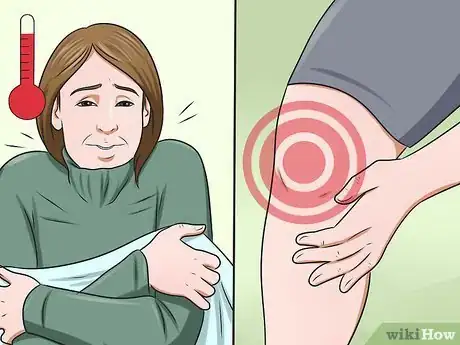
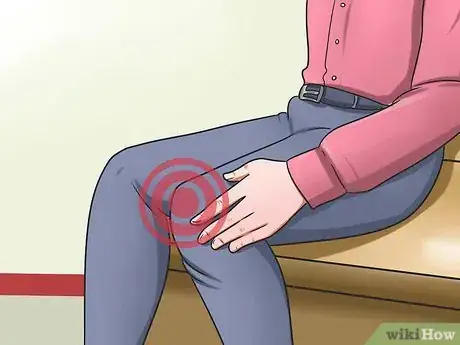
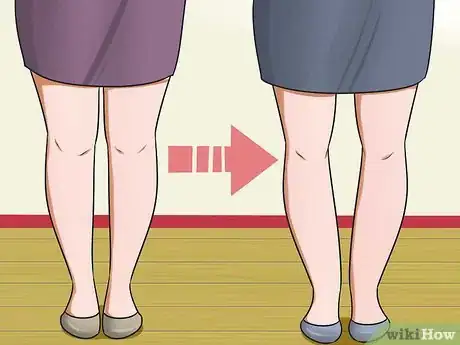
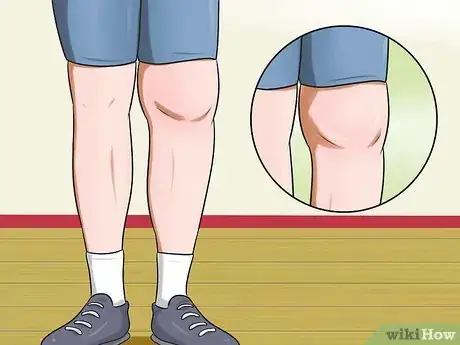
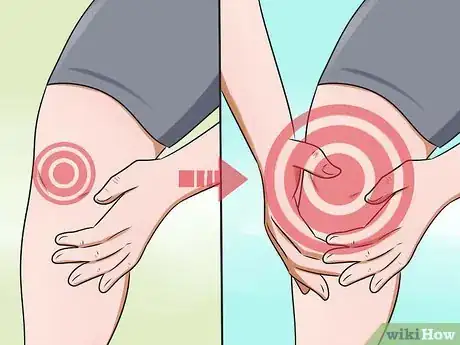
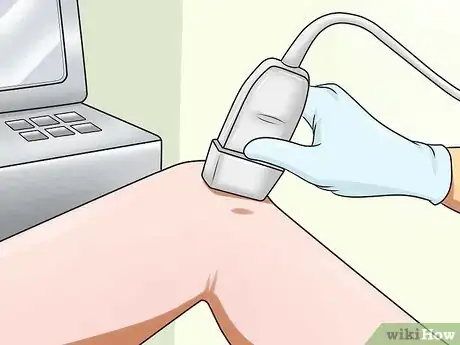

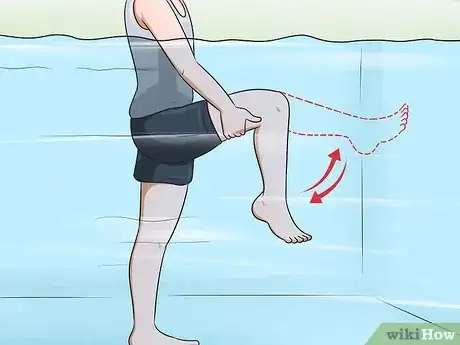

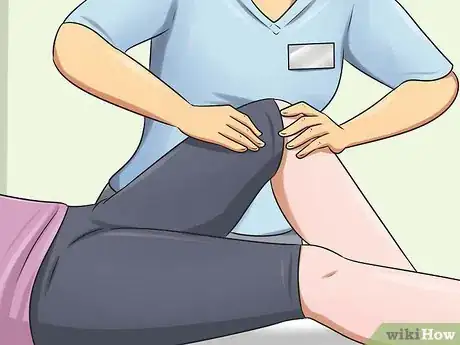
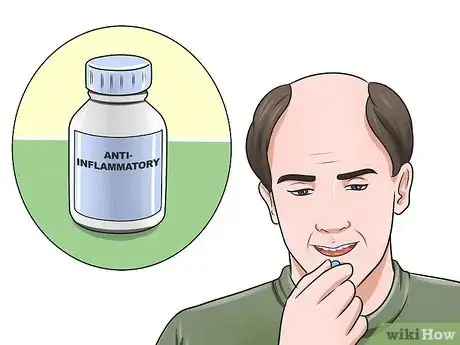
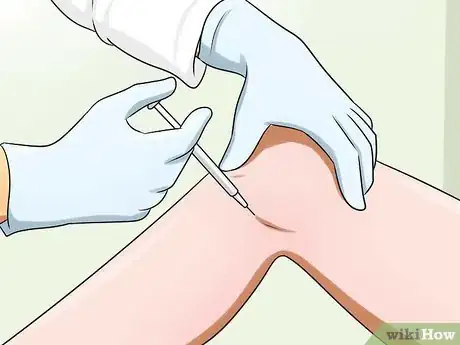
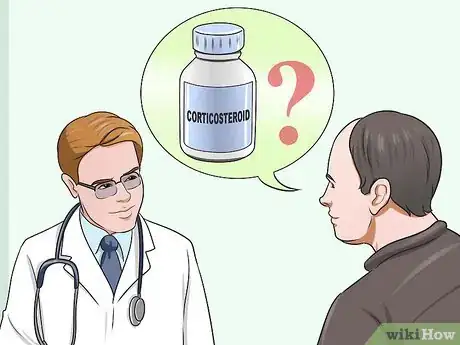


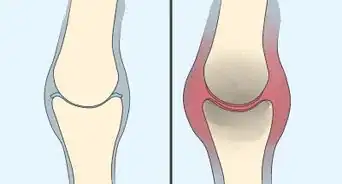




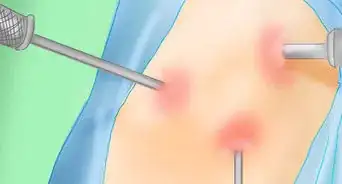

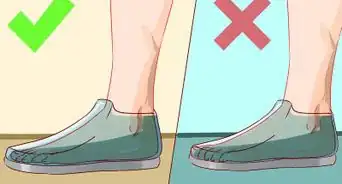





















































Medical Disclaimer
The content of this article is not intended to be a substitute for professional medical advice, examination, diagnosis, or treatment. You should always contact your doctor or other qualified healthcare professional before starting, changing, or stopping any kind of health treatment.
Read More...